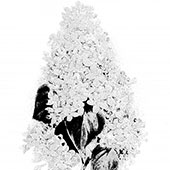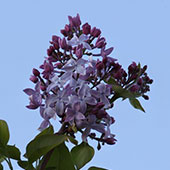Clarke, 1948
‘Clarke’s Giant’, S. ×hyacinthiflora
Clarke 1948; S III
syn. – ‘Clark‛s Giant’
{unnamed double seedling × ? }
Clarke, US Plant Patent No. 754 [Aug. 26, 1947] – as S. vulgaris; Clarke, Cat. vol. 15, 8 [1948]; Woody Plant Register, AAN, No. 65 [1949]; Wister, Lilacs for America, 27 [1953]; Photo on Jorgovani/Lilacs 2015 DVD.
Awards: RHS Award of Merit 1958.
cultivar name presumed registered 1953; name established and accepted.
Международный регистр названий культиваров рода Syringa L.
Its novelty resides primarily in the unique coloring of the flowers at the different stages of their development, and in the enormous size of the individual florets, the great size and shape of the thyrses, the large green leaves and the vigorous, erect growth of the bush. The plant is the result of definite breeding efforts carried on by me and my associates since 1932. Asexual reproduction by budding and grafting has proved these features to be firmly fixed.
In general plant structure this new variety is similar to the well-known Syringa vulgaris. But this new variety differs distinctly from all varieties of Syringa vulgaris known to me. The individual flower has the usual bell-shaped, four-toothed calyx, and salverform, four-lobed corolla. The leaves are a deep green in color and very large but are otherwise similar in form and texture to the parent strain, being ovate-cordate in form and growing opposite each other in pairs. It is a vigorous grower. There are no large plants of this new variety in existence at this time, but its buds and grafts made for testing have both bloomed when only a year old.
The accompanying painting shows a panicle of the new lilac in its natural colors.
Referring to the novel characteristics of this new variety; each floret is enormous in size, up to one and one-half inches wide, thus giving great size to the thyrses which, instead of being conical in shape as are those of most lilacs, show a pronounced flattening on four sides, giving the effect of an elongated four-sided pyramid. The flower is particularly striking in the half-open stage when the unopen buds toward the top of the cluster are soft pinkish mauve in color while the fully developed flowers at the bottom have a beautiful sky-blue tone.
WALTER BOSWORTH CLARKE. Авторское описание для Патентной службы США
Кларкс Джайант Clarke’s Giant. РГЖ (*)
Бутоны темно-фиолетовые; цветки нежно-голубые, с лиловатым оттенком, очень крупные (3,2 см), простые, слабодушистые; лепестки овальные, с заостренными кончиками, плоские, при отцветании сильно загибающиеся назад. Соцветия чаще из одной пары очень крупных (35х20 см), прочных, но сильно разреженных, прерывистых метелок, иногда с небольшими листьями в основании. Листья очень крупные, широкие, темно-зеленые, с матовым оттенком. Кусты сильнорослые, редкие, прямые, с толстыми серокорыми побегами и большими междоузлиями. Рекомендуется для оформления
«ВИДЫ И СОРТА СИРЕНИ, КУЛЬТИВИРУЕМЫЕ В СССР» Л.И. Рубцов, Н.Л. Михайлов, В. Г. Жоголева, Киев, Наукова Думка, 1980
(*) РГЖ – ранний гибрид Жиральди (S. oblata var. giraldii Rehd.)




Оставить комментарий
Пожалуйста, зарегистрируйтесь, чтобы иметь возможность оставлять комментарии.